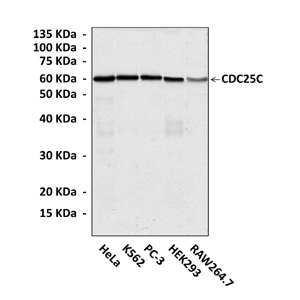Anti-CDC25C: Mouse CDC25C Antibody |
 |
BACKGROUND CDC25 is a dual specificity phosphatase with three isoforms in mammalian cells - CDC25A, B and C. CDC25 activates Cdk complexes that control progression through the cell cycle. CDC25 is also involved in the DNA damage checkpoints. Regulation of CDC25 occurs through a variety of mechanisms including phosphorylation, interaction with 14.3.3 proteins, subcellular localization and protein degradation.1 CDC25B is phosphorylated and activated by aurora kinase A at the start of mitosis, and as mitosis progresses is then further phosphorylated in an auto-amplification loop, along with CDC25C, by the CDK1/cyclin B complex. Cdc25C is also phosphorylated during mitosis by PLK1, leading to greater activity of the CDK1/cyclin B complex. Similarly, CDC25A acts during the G1/S phase of the cell cycle in concert with the CDK2/cyclin E complex. Both CDC25A and CDC25B can be activated by the DNA damage checkpoint kinase, Chk1 and thereby inhibit mitosis.2
CDC25C is highly conserved during evolution and it plays a key role in the regulation of cell division. It is a tyrosine phosphatase and directs dephosphorylation of cyclin B-bound CDC2 and triggers entry into mitosis.3 It is also thought to suppress p53-induced growth arrest. Multiple alternatively spliced transcript variants of this gene have been described.
CDC25C is highly conserved during evolution and it plays a key role in the regulation of cell division. It is a tyrosine phosphatase and directs dephosphorylation of cyclin B-bound CDC2 and triggers entry into mitosis.3 It is also thought to suppress p53-induced growth arrest. Multiple alternatively spliced transcript variants of this gene have been described.
REFERENCES
1. Turowski,P. et al: Mol. Biol. Cell 14: 2984-98, 2003
2. Zwicker, J. et al: EMBO J. 14:4514-22, 1995
3. Mitra, J. & Schultz, R.M.: J. Cell Sci. 109:2407-2415, 1996
2. Zwicker, J. et al: EMBO J. 14:4514-22, 1995
3. Mitra, J. & Schultz, R.M.: J. Cell Sci. 109:2407-2415, 1996
Products are for research use only. They are not intended for human, animal, or diagnostic applications.
Параметры
Cat.No.: | CP10296 |
Antigen: | Raised against recombinant human CDC25C fragments expressed in E. coli. |
Isotype: | Mouse IgG1 |
Species & predicted species cross- reactivity ( ): | Human, Mouse, Rat |
Applications & Suggested starting dilutions:* | WB 1:1000 IP n/d IHC n/d ICC n/d FACS n/d |
Predicted Molecular Weight of protein: | 60 kDa |
Specificity/Sensitivity: | Detects endogenous CDC25C proteins without cross-reactivity with other family members. |
Storage: | Store at -20°C, 4°C for frequent use. Avoid repeated freeze-thaw cycles. |
*Optimal working dilutions must be determined by end user.
Документы
Информация представлена исключительно в ознакомительных целях и ни при каких условиях не является публичной офертой








